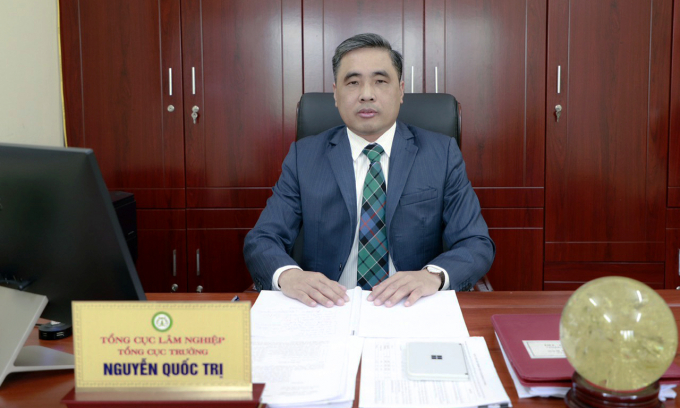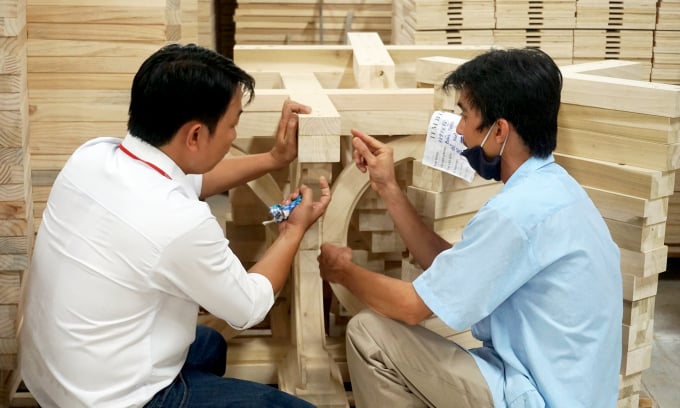April 14, 2025 | 18:49 GMT +7
April 14, 2025 | 18:49 GMT +7
Hotline: 0913.378.918
April 14, 2025 | 18:49 GMT +7
Hotline: 0913.378.918

Mr. Nguyen Quoc Tri, Director General of Vietnam Administration of Forestry.
On the occasion of Vietnam Forestry Day (November 28th) and the 76th anniversary of the establishment of Vietnam’s forestry sector (December 1st, 1945 - December 1st, 2021), Mr. Nguyen Quoc Tri, Director General of Vietnam Administration of Forestry (Ministry of Agriculture and Rural - MARD) shared about the sector’s achievements and orientations In the period when the entire agriculture and rural development sector is transforming into a multi-valued, sustainable and internationally integrated agriculture.
Executing Executive Order No. 69 dated December 1st, 1945 of President Ho Chi Minh, the forestry sector has been formed and developed through many ups and downs along with the country's history. Could you please review the important milestones during this difficult but also proud time?
The forestry sector has gone through many ups and downs along with the country's history, which can be summarized in three main periods.
The first period from 1945 to 1975 was when the forestry was in service of the resistance war and the construction of the nation with three main tasks: construct a system of forestry policies and regulations, perform forest protection, research on forestry science.
The second period from 1976 to 1991 was the period when the existence of the forestry sector was to heal the wounds of war and restore the country's economy.
Although it had made great contributions to stabilizing people's lives and solving hunger, this was also a period when we had to make trade-offs, witnessing the promotion of logging. Forests gave way to economic development, forest land converted into production zones for food, serving migrants through sedentary and settlement programs.

Deputy Minister of Agriculture and Rural Development Le Quoc Doanh (centre) inspecting forest fire prevention in Thanh Hoa. Photo: Vu Ngoc Luat.
In the third phase from 1991 up to the present there have been strong and fundamental reforms towards sustainable development in the context of the whole country building a socialist-oriented market economy. The forestry sector shifted from the state-owned status to become a multi-sectoral economy.
The forestry sector is gradually adjusted towards the economy - technology direction which includes forest management, protection, development and use as well as forest products processing and trading.
The forestry industry is deeply integrated into the international community during this period, participating and being a responsible member amid the implementation of international conventions and free trade documents, paving the way for the development of the forestry sector stably on all three pillars: Economy - Society - Environment.
Regardless of circumstances, the forestry sector always promotes its initiative and creativity, contributing to making the agricultural sector the backbone of the economy. What are those achievements in particular?
The forestry sector promptly advised the MARD to promulgate and submit to the Government many documents, concretizing the provisions of the law on forestry. The documents are always consistent with the requirements of forest protection and development, having punctuality and synchronization guaranteed.
In regard to scientific research, from 1994 up to now, the forestry sector has recognized 216 new varieties, also researches and manufactures tools and equipment for mechanization of production stages, researches on wood modification technology, creates new materials from planted forest wood into auxiliary materials for processing, researches on wood preservation and processing in order to improve usage efficiency.

Forest rangers controlling drones to inspect forest fires. Photo: GIZ/Binh Dang.
As for professional training, the forestry sector currently has approximately 50 professors, associate professors, 96 doctors, 4,145 masters, and 47,348 engineers.
Regarding international cooperation, the sector actively participates in a responsible manner in international conventions, multilateral organizations, global and regional forestry forums with 34 cooperation focal points.
In terms of forest protection, the forestry sector has greatly contributed to reducing violations of legal regulations on forest protection. The average number of violations in the period 2006-2010 was 39,165 cases/year. By 2011-2015, this number was 27,265 cases/year. In the 2016-2020 period, there are only 16,600 cases/year, equivalent to 42.4% of the number of cases in the 2006-2010 period and 60.8% in the 2011-2015 period.

Wooden furniture processing and exportation is currently a pointed sector of the forestry industry. Photo: TL.
Regarding afforestation, approximately 230,000 ha are planted annually. The average yield of planted forests is 15-20m3/ha/year. The yield of the main plant species is 90-100m3/ha.
As for forest products processing and exportation, up to the present date, the forestry industry has achieved an export turnover of USD 14.26 billion, up 21% over the same period last year. The USA, Japan, China, the EU, and South Korea are the most important export markets.
In terms of forest environment services, the whole country has earned VND 2,974.26 billion accumulated by November 2021, reaching 106% of the 2021 revenue plan, equivalent to 129% of the same period in 2020.

Forestry officials are proactive and drastic in forest protection and development activities. Photo: TL.
As an export spearhead of the agricultural sector, with the goal of increasing the value of forestry production by an average of 5.0-5.5%, what plans and objectives will the forestry sector implement in the coming time to maintain its position and growth rate?
The forestry sector’s orientation is to continue to develop sustainably on the basis of effective management and use of forest resources, in harmony with economic, social, and environmental protection objectives.
The goal is to make forestry a modern, efficient, and highly competitive economic-technical sector, linking in chains from forest development, forest protection, forest use to forest product processing and trade to improve the value of the sector and draw out the multi-valued feature of forests.
The forestry sector will strictly manage, protect and restore natural forests. These acts go in line with biodiversity conservation, landscape protection, ecological environment, water security, and planted forests quality improvement.

Forest rangers patrolling the forest. Photo: TL.
The sector’s aims in the 2021-2030 period are as follows:
The national forest coverage rate is stable at 42-43%. The growth rate of forestry production value reaches 5 to 5.5%. Export value of wood and forest products reaches USD 20 billion in 2025 and USD 25 billion in 2030.
Total revenue from forest environmental services increases by 5%/year on average. Timber production from planted forests reaches 35 million m3 in 2025, 50 million m3 in 2030. Forest areas certified for sustainable forest management reach over 500,000 ha in the 2021-2025 period, over 1 million ha in the period 2026- 2030.
Thank you, sir!
Translated by Samuel Pham

(VAN) The results from pilot fields are catalyzing the expansion of the One million hectares of high-quality, low-emission rice project in Kien Giang.

(VAN) On the morning of April 11, Cuc Phuong National Park received 18 individuals of endangered and rare wild animals from Da Nang city.

(VAN) FAO supports Vietnam in enhancing survey sampling techniques for the 2025 nationwide agricultural and rural census.

(VAN) By participating in the green transition, manufacturers become an indispensable part of the circular economy, contributing to resource optimization and environmental protection.

(VAN) The One Million Hectares of High-Quality and Low-Emission Rice Program can generate nearly 14 million tons of straw annually, posing an urgent requirement to diversify straw-based products.

(VAN) This figure was recently announced at a conference held in Yen Bai, focusing on climate-resilient infrastructure development for ethnic minority regions.

(VAN) The evacuation center is a practical work in efforts to respond to natural disasters and adapt to climate change in vulnerable areas.